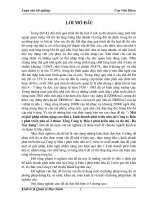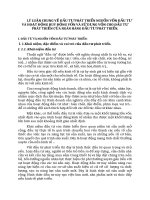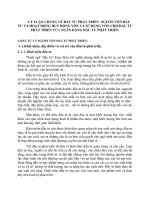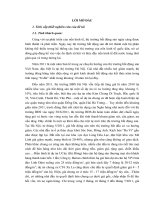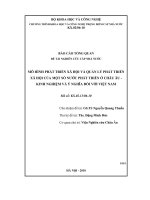Phát triển các phương pháp tối ưu hóa thông minh cho các bài toán cơ học
Bạn đang xem bản rút gọn của tài liệu. Xem và tải ngay bản đầy đủ của tài liệu tại đây (1.69 MB, 144 trang )
MINISTRY OF EDUCATION AND TRAINING
HO CHI MINH CITY
UNIVERSITY OF TECHNOLOGY AND EDUCATION
LAM PHAT THUAN
DEVELOPMENT OF META-HEURISTIC OPTIMIZATION
METHODS FOR MECHANICS PROBLEMS
PHD THESIS
MAJOR: ENGINEERING MECHANICS
Ho Chi Minh City, 01/2021
THE WORK IS COMPLETED AT
HCM CITY UNIVERSITY OF TECHNOLOGY AND EDUCATION
LAM PHAT THUAN
DEVELOPMENT OF META-HEURISTIC
OPTIMIZATION METHODS FOR MECHANICS
PROBLEMS MAJOR: ENGINEERING MECHANICS 13252010105
Supervisor 1: Assoc. Prof. NGUYEN HOAI SON
Supervisor 2: Assoc. Prof. LE ANH THANG
PhD thesis is protected in front of
EXAMINATION COMMITTEE FOR PROTECTION OF DOCTORAL THESIS
HCM CITY UNIVERSITY OF TECHNOLOGY AND EDUCATION
Date……month……year……
ii
ORIGINALITY STATEMENT
I, Lam Phat Thuan, hereby assure that this dissertation is my own work.
The data and results stated in this dissertation are honest and have not been
published by any works.
Ho Chi Minh City, January 2021
Lam Phat Thuan
ACKNOWLEDGEMENTS
This dissertation has been carried out in the Faculty of Civil Engineering, HCM
City University of Technology and Education, Viet Nam. The process of conducting
this thesis brings excitement but has quite a few challenges and difficulties. And I
can say without hesitation that it has been finished thanks to the encouragement,
support and help of my professors and colleagues.
First of all, I would like to express my deepest gratitude to Assoc. Prof. Dr. Nguyen
Hoai Son and Assoc. Prof. Le Anh Thang, especially Assoc. Prof. Dr. Nguyen Hoai
Son from GACES Group, Ho Chi Minh City University of Technology and
Education, Vietnam for having accepted me as their PhD student and for the
enthusiastic guidance and mobilization during my research.
Secondly, I would like also to acknowledge Msc. Ho Huu Vinh for his
troubleshooting and the cooperation in my study. Furthermore, I am grateful to
Civil Engineering Faculty for their great support to help me have good environment
to do my research.
Thirdly, I take this chance to thank all my nice colleagues at the Faculty of Civil
Engineering, Ho Chi Minh City University of Technology and Education, for their
professional advice and friendly support.
Finally, this dissertation is dedicated to my parents who have always given me
valuable encouragement and assistance.
Lam Phat Thuan
i
ABSTRACT
Almost all design problems in engineering can be considered as optimization
problems and thus require optimization techniques to solve. During the past few
decades, many optimization techniques have been proposed and applied to solve a
wide range of various optimization problems. Among them, meta-heuristic
algorithms have gained huge popularity in recent years in solving design
optimization problems of many types of structure with different materials. These
meta-heuristic algorithms include genetic algorithms (GA), particle swarm
optimization (PSO), bat algorithm (BA), cuckoo search (CS), differential evolution
(DE), firefly algorithm (DA), harmony search (HS), flower pollination algorithm
(FPA), ant colony optimization (ACO), bee algorithms (BA), Jaya algorithm and
many others. Among the methods mentioned above, the Differential Evolution is
one of the most widely used methods. Since it was first introduced in 1997 by Storn
and Price [1], many studies have been carried out to improve and apply DE in
solving structural optimization problems. The DE has demonstrated excellently
performance in solving many different engineering problems. Besides the
Differential Evolution algorithm, the Jaya algorithm recently proposed by Rao [2] in
2016 is also an effective and efficient methods that has been widely applied to solve
many optimization problems and showed its good performance. It gains dominate
results when being tested with benchmark test functions in comparison with other
meta-heuristic methods. However, like many other population-based optimization
algorithms, one of the disadvantages of DE and Jaya is that the computational time
obtaining optimal solutions is much slower than the gradient-based optimization
methods. This is because DE and Jaya takes a lot of time evaluating the fitness of
individuals in the population. To overcome this disadvantage, Artificial Neuron
Networks (ANN) are studied to combine with the meta-heuristic algorithms, such as
Differential Evolution, to form a new approach which has the ability to solve the
design optimization effectively. Moreover, one of the most important issues in
engineering design is that the optimal designs are often effected by uncertainties
which can be occurred from various sources, such as
i
manufacturing processes, material properties and operating environments. These
uncertainties may cause structures to improper performance as in the original
design, and hence may result in risks to structures [3]. Therefore, reliability-based
design optimization (RBDO) can be considered as an important and comprehensive
strategy for finding an optimal design.
In this dissertation, an improved version of Differential Evolution has been first
time utilized to solve for optimal fiber angle and thickness of the reinforced
composite. Secondly, the Artificial Neural Network is integrated to the optimization
process of the improved Differential Evolution algorithm to form a new algorithm
call ABDE (ANN-based Differential Evolution) algorithm. This new algorithm is
then applied to solve optimization problems of the reinforced composite plate
structures. Thirdly, an elitist selection technique is utilized to modify the selection
step of the original Jaya algorithm to improve the convergence of the algorithm and
formed a new version of the original Jaya called iJaya algorithm. The improved
Jaya algorithm is then applied to solve for optimization problem of the Timoshenko
composite beam and obtained very good results. Finally, the so-called called
(SLMD-iJaya) algorithm which is the combination of the improved Jaya algorithm
and the Global Single-Loop Deterministic Methods (SLDM) has been proposed as a
new tool set for solving the Reliability-Based Design Optimization problems. This
new method is applied to look for optimal design of Timoshenko composite beam
structures with certain level of reliability.
iv
TĨM TẮT
Hầu như các bài tốn thiết kế trong kỹ thuật có thể được coi là những bài tốn tối ưu
và do đó địi hỏi các kỹ thuật tối ưu hóa để giải quyết. Trong những thập kỷ qua,
nhiều kỹ thuật tối ưu hóa đã được đề xuất và áp dụng để giải quyết một loạt các vấn
đề khác nhau. Trong số đó, các thuật tốn meta-heuristic đã trở nên phổ biến trong
những năm gần đây trong việc giải quyết các vấn đề tối ưu hóa thiết kế của nhiều
loại cấu trúc với các vật liệu khác nhau. Các thuật toán meta-heuristic này bao gồm
Genetic Algorithms, Particle Swarm Optimization, Bat Algorithm, Cuckoo Search,
Differential Evolutioin, Firefly Algorithm, Harmony Search, Flower Pollination
Algorithm, Ant Colony Optimization, Bee Algorithms, Jaya Algorithm và nhiều
thuật toán khác. Trong số các phương pháp được đề cập ở trên, Differential
Evolution là một trong những phương pháp được sử dụng rộng rãi nhất. Kể từ khi
được Storn và Price [1] giới thiệu lần đầu tiên, nhiều nghiên cứu đã được thực hiện
để cải thiện và áp dụng DE trong việc giải quyết các vấn đề tối ưu hóa cấu trúc. DE
đã chứng minh hiệu suất tuyệt vời trong việc giải quyết nhiều vấn đề kỹ thuật khác
nhau. Bên cạnh thuật toán Differential Evolution, thuật toán Jaya được Rao [2] đề
xuất gần đây cũng là một phương pháp hiệu quả và đã được áp dụng rộng rãi để giải
quyết nhiều vấn đề tối ưu hóa và cho thấy hiệu suất tốt. Nó đạt được kết quả vượt
trội khi được thử nghiệm với các hàm test benchmark so với các phương pháp dựa
trên dân số khác. Tuy nhiên, giống như nhiều thuật tốn tối ưu hóa dựa trên dân số
khác, một trong những nhược điểm của DE và Jaya là thời gian tính tốn tối ưu
chậm hơn nhiều so với các phương pháp tối ưu hóa dựa trên độ dốc (gradient-based
algorithms). Điều này là do DE và Jaya mất rất nhiều thời gian để đánh giá hàm
mục tiêu của các cá thể trong bộ dân số. Để khắc phục nhược điểm này, các mạng
nơ ron nhân tạo (Artificial Neural Networks) được nghiên cứu để kết hợp với các
thuật toán meta-heuristic, như Differential Evolution, để tạo thành một phương
pháp tiếp cận mới giúp giải quyết
v
các bài tốn tối ưu hóa thiết kế một cách hiệu quả. Bên cạnh đó, một trong những
vấn đề quan trọng nhất trong thiết kế kỹ thuật là các thiết kế tối ưu thường bị ảnh
hưởng bởi những yếu tố ngẫu nhiên. Những yếu tố này có thể xảy ra từ nhiều nguồn
khác nhau, chẳng hạn như quy trình sản xuất, tính chất vật liệu và mơi trường vận
hành và có thể khiến các cấu trúc hoạt động khơng đúng như trong thiết kế ban đầu,
và có thể dẫn đến rủi ro cho các cấu trúc [3]. Do đó, tối ưu hóa thiết kế dựa trên độ
tin cậy (Reliability-Based Design Optimization) có thể được coi là một chiến lược
tồn diện, cần thiết để tìm kiếm một thiết kế tối ưu.
Trong luận án này, lần đầu tiên một phiên bản cải tiến của phương pháp Differential
Evolution đã được sử dụng để tìm góc hướng sợi tối ưu và độ dày của tấm gia
cường vật liệu composite. Thứ hai, Mạng nơ ron nhân tạo (ANN) được tích hợp vào
quy trình tối ưu hóa thuật tốn Differentail Evolution cải tiến để hình thành thuật
toán mới gọi là thuật toán ABDE (Artificial Neural Network-Based Differential
Evolution). Thuật tốn mới này sau đó được áp dụng để giải quyết các bài tốn tối
ưu hóa của các cấu trúc tấm composite gia cường. Thứ ba, một kỹ thuật lựa chọn
tinh hoa (Elitist Selection Technique) được sử dụng để hiệu chỉnh bước lựa chọn
của thuật toán Jaya ban đầu để cải thiện sự hội tụ của thuật toán và hình thành một
phiên bản mới của thuật tốn Jaya được gọi là thuật toán iJaya. Thuật toán Jaya cải
tiến (iJaya) sau đó được áp dụng để giải quyết bài tốn tối ưu hóa dầm Timoshenko
vật liệu composite và thu được kết quả rất tốt. Cuối cùng, thuật toán mới SLMDiJaya được tạo thành từ sự kết hợp giữa thuật tốn Jaya cải tiến và phương pháp
vịng lặp đơn xác định (Single-Loop Deterministic Method) đã được đề xuất như
một công cụ mới để giải quyết các vấn đề Tối ưu hóa thiết kế dựa trên độ tin cậy.
Phương pháp mới này được áp dụng để tìm kiếm thiết kế tối ưu của các cấu trúc
dầm composite Timoshenk và cho kết quả vượt trội.
vi
CONTENTS
ORIGINALITY STATEMENT................................................................................i
ACKNOWLEDGEMENTS.....................................................................................ii
ABSTRACT.............................................................................................................iii
CONTENTS............................................................................................................vii
NOMENCLATURE..................................................................................................x
LIST OF TABLES.................................................................................................xiii
LIST OF FIGURES...............................................................................................xiv
CHAPTER 1..............................................................................................................1
1.1
An overview on research direction of the thesis.......................................1
1.2
Motivation of the research..........................................................................6
1.3
Goals of the dissertation..............................................................................6
1.4
Research scope of the dissertation.............................................................7
1.5
Outline..........................................................................................................7
1.6
Concluding remarks....................................................................................9
CHAPTER 2............................................................................................................10
2.1
Introduction to Composite Materials......................................................10
2.1.1
Basic concepts and applications of Composite Materials...............10
2.1.2
Overview of Composite Material in Design and Optimization......16
2.2
Analysis of Timoshenko composite beam................................................18
2.2.1.
Exact analytical displacement and stress......................................18
2.2.2.
Boundary-condition types...............................................................22
2.3
Analysis of reinforced composite plate....................................................23
CHAPTER 3............................................................................................................26
vi
3.1
Overview of Metaheuristic Optimization................................................26
3.1.1
Meta-heuristic Algorithm in Modeling.............................................27
3.1.2
Meta-heuristic Algorithm in Optimization......................................31
3.2
Solving Optimization problems using improved Differential Evolution
41
3.2.1
Brief on the Differential Evolution algorithm [14], [129]...............42
3.2.2
The
modified
algorithm
Roulette-Wheel-Elitist
Differential
Evolution..........................................................................................................43
3.3
Solving Optimization problems using improved Jaya algorithm.........44
3.3.1
Jaya Algorithm...................................................................................44
3.2.2
Improvement version of Jaya algorithm..........................................45
3.4
Reliability-based design optimization using a global single loop
deterministic method..........................................................................................46
3.4.1.
Reliability-based optimization problem formulation...................48
3.4.2.
A global single-loop deterministic approach................................49
CHAPTER 4............................................................................................................53
4.1
Fundamental theory of Neural Network.................................................53
4.1.1
Basic concepts on Neural Networks [146]........................................55
4.1.2
Neural Network Structure.................................................................56
4.1.3
Neural Network Design Steps............................................................60
4.1.4
Levenberg-Marquardt training algorithm.......................................61
4.1.5
Over fitting, Over training.................................................................63
4.2
Artificial Neural Network based meta-heuristic optimization methods
65
CHAPTER 5............................................................................................................68
vi
5.1
Verification of iDE algorithm...................................................................68
5.1.1
A 10-bars planar truss structure.......................................................68
5.1.2
A 200-bars truss structure.................................................................70
5.1.3
A 72-bar space truss structure..........................................................72
5.1.4
A 120-bar space truss structure:.......................................................75
5.2
Static analysis of the reinforced composite plate....................................77
5.3
The effective of the improved Differential Evolution algorithm...........79
5.4
Optimization of reinforced composite plate............................................80
5.4.1
Thickness optimization of stiffened Composite plate......................80
5.4.2
Artificial neural network-based optimization of reinforced
composite plate................................................................................................82
5.5
Deterministic optimization of composite beam.......................................85
5.5.1
Optimal design with variables: b and h............................................86
5.5.2
Optimal design with variables: b and ti...................................................................89
5.6
Reliability-based optimization design of Timoshenko composite beam
93
5.6.1
Verification of SLDM-iJaya..............................................................93
5.6.2
Reliability-based lightweight design.................................................95
CHAPTER 6............................................................................................................98
6.1
Conclusions and Remarks........................................................................98
6.2
Recommendations and future works.....................................................101
REFERENCES......................................................................................................103
LIST OF PUBLICATIONS.................................................................................118
ix
NOMENCLATURE
Latin Symbols
b
The width of the composite beam
Cij
Matrix of stiffness
Dm , Dmb , Db , Ds
Material matrices of composite plate
Db , Ds
Material matrices of composite beam
st
st
E
Young modulus
F
Loading vector
G
Shear modulus
h,t
The thickness of the composite beam/plate
K
Stiffness matrix of the plate
L
Length of the composite beam
m
Number of constraint satisfactions
N
Number of layers of composite materials
NP
Size of population
CR
Crossover control parameter
p
Vector of random parameters
Q
Matrix of material stiffness coefficients
S
Matrix of compliance
T
Coordinate transformation matrix
u(x), w(x)
Displacement field of the composite beam
x
Vector of design variables
X
Population set
wji
Vector of weights
Greek Symbols
Poison’s ratio
x
Natural frequency
Mass density
Stress field
xx
Normal stress in x direction
yy
Normal stress in y direction
xy
Shear stress in xy direction
yz
Shear stress in yz direction
xz
Shear stress in xz direction
Strain field
xx
Normal strain in x direction
yy
Normal strain in y direction
xy
Shear strain in xy direction
yz
Shear strain in yz direction
xz
Shear strain in xz direction
x
Mean vector of x
j
Distance between feasible and infeasible design region
Abbreviations
2D
Tow dimension
3D
Three dimension
ANN
Artificial Neural Network
MLP
Multi-Layer Perceptron
DE
Differential Evolution
iDE
improved Differential Evolution
ABDE
Artificial neural network-Based Differential Evolution
xi
PSO
Particle Swarm Optimization
GA
Genetic Algorithm
FA
Firefly Algorithms
HS
Harmony Search
SLDM
Single Loop Deterministic Method
RBDO
Reliability Based Design Optimization
DOF
Degree Of Freedom
ADO
Approximate Deterministic Optimization
MPP
Most Probable Point
CS-DSG3
Cell-Smoothed Discrete Shear Gap technique using
triangle finite element
xi
LIST OF TABLES
TABLES
PAGE
Table 5. 1. Parameters for 10 bars truss...................................................................69
Table 5. 2. The comparison results keep the solution from the improved DE algorithm
with other methods for the 10-bar flattening problem..............................................70
Table 5. 3. Parameter for 200-bars truss structure...................................................72
Table 5. 4. Results of the comparison between the solution from the improved DE
algorithm and other methods for the problem of optimizing the 200-bar scaffold
problem.....................................................................................................................73
Table 5. 5. Parameters for 72-bars space truss structure..........................................74
Table 5. 6. Comparison between the solution from iDE algorithm with other
methods for the the 72-bars space truss problem......................................................75
Table 5. 7. Parameters for 120-bars arch space truss structure................................76
Table 5. 8. Results of comparison of solutions from the improved DE algorithm
with other methods for the optimization problem of space bar of 120 bars.............77
Table 5. 9. Comparison of central deflection (mm) of the simply-supported square
reinforced composite plates......................................................................................78
Table 5. 10. The optimal results of two problems....................................................80
Table 5. 11. Optimal thickness results for reinforced composite plate problems 82
Table 5. 12 Sampling and overfitting checking error...............................................83
Table 5. 13. Comparison of the accuracy and computational time between DE and
ABDE........................................................................................................................84
Table 5. 14. Material properties of lamina...............................................................87
Table 5. 15. Comparison of optimal design with continuous design variables........88
Table 5. 16. Comparison of optimal design with discrete design variables.............90
Table 5. 17. Comparison of optimization results of the mathematical problem......94
Table 5. 18. Optimal results of reliability based lightweight design with different
level of reliability......................................................................................................96
xi
LIST OF FIGURES
FIGURES
PAGE
Figure 2. 1. Types of fiber-reinforced composites...................................................12
Figure 2. 2. Boeing 787 - first commercial airliner with composite fuselage and
wings. (Courtesy of Boeing Company.)...................................................................13
Figure 2. 3. Composite mixer drum on concrete transporter truck weighs 2000 lbs
less than conventional steel mixer drum...................................................................14
Figure 2. 4. Pultruded fiberglass composite structural elements. (Courtesy of
Strongwell Corporation.)..........................................................................................15
Figure 2. 5. Composite wind turbine blades. (Courtesy of GE Energy.).................15
Figure 2. 6. Composite laminated beam model.......................................................19
Figure 2. 7. Free-body diagram................................................................................19
Figure 2. 8. The material and laminate coordinate system......................................20
Figure 2. 9. A composite plate reinforced by an r-direction beam..........................24
Figure 3. 1. Source of inspiration in meta-heuristic optimization algorithms.........33
Figure 3. 2. Illustration of the feasible design region..............................................50
Figure 4. 1. Biological neuron.................................................................................53
Figure 4. 2. Perceptron neuron of Pitts and McCulloch...........................................54
Figure 4. 3. Applying a model based on field data..................................................55
Figure 4. 4. The relationship between Machine Learning and the neural network 56
Figure 4. 5. A Multi-layer perceptron network model.............................................57
Figure 4. 6. Single node in an MLP network...........................................................57
Figure 4. 7. Tanh and Sigmoid function...................................................................58
Figure 4. 8. A multi-layer perceptron with one hidden layer. Both layers use the
same activation function g........................................................................................59
Figure 4. 9. Diagram for the training process of a neural network with the
Levenberg- Marquardt algorithm..............................................................................63
Figure 4. 10. Dividing the training data for the validation process.........................65
Figure 4. 11. Optimization process using Artificial Neural Network (ANN) based
Differential Evolution (ABDE) optimization algorithm...........................................66
Figure 5. 1. A 10-bars truss structure.......................................................................69
Figure 5. 2. A 200 bars truss structure.....................................................................71
xi
Figure 5. 3. A 72-bars space truss structure.............................................................74
Figure 5. 4. Structure of 120-bars arch space truss..................................................76
Figure 5. 5. Model of a reinforced composite plate.................................................77
Figure 5. 6. Models of square and rectangular reinforced composite plates............79
Figure 5. 7. Model of reinforced composite plate for optimization.........................81
Figure 5. 8. Convergence curves of DE, IDE, Jaya and iJaya for the beam with P-P
condition...................................................................................................................89
Figure 5. 9. Convergence curves of DE, IDE, Jaya and iJaya for the beam with P-P
condition...................................................................................................................91
Figure 5. 10. Comparison of different design approaches with different boundary
conditions..................................................................................................................92
Figure 5. 11. Comparison of RBDO optimal results with different levels of reliability
...................................................................................................................................97
x
CHAPTER 1
LITERATURE REVIEW
1.1 An overview on research direction of the thesis
Almost all design problems in engineering can be considered as optimization
problems and thus require optimization techniques to solve. However, as most realworld problems are highly non-linear, traditional optimization methods usually do
not work well. The current trend is to use evolutionary algorithms and metaheuristic optimization methods to tackle such nonlinear optimization problems.
Meta-heuristic algorithms have gained huge popularity in recent years. These metaheuristic algorithms include genetic algorithms, particle swarm optimization, bat
algorithm, cuckoo search, differential evolution, firefly algorithm, harmony search,
flower pollination algorithm, ant colony optimization, bee algorithms, Jaya
algorithm and many others. The popularity of meta-heuristic algorithms can be
attributed to their good characteristics because these algorithms are simple, flexible,
efficient, adaptable and yet easy to implement. Such advantages make them versatile
to deal with a wide range of optimization problems, especially the structural
optimization problems [4]. Structural optimization is a potential field and has
attracted the attention of many researchers around the world. During the past decades,
many optimization techniques have been proposed and applied to solve a wide range
of various problems. The algorithms can be classified into two main groups:
gradient-based and popular-based approach. Some of the gradient-based
optimization methods can be named here as sequential linear programming (SLP)
[5], [6], sequential quadratic programming (SQP) [7], [8], Steepest Descent Method,
Conjugate Gradient Method, Newton's Method [9]. The gradient-based methods are
very fast in reaching the optimal solution, but easy trapped in local extrema and
requires the gradient information to construct the searching algorithm. Besides, the
gradient-based approaches are limited to continuous design variables and that
decreases the productivity of the algorithm. In addition, the initial solution (or
initial design parameters of the structure) also
greatly affects the ability to achieve global or local solutions of gradient-based
algorithms. The population-based techniques, also known as part of meta-heuristic
algorithms, can be listed such as genetic algorithm (GA), differential evolution
(DE), and particle swarm optimization (PSO), Cuckoo Search (CS), Firefly
Algorithm (FA), etc [10]. These methods are used extensively in structural
problems because of their flexibility and efficiency in handling both continuous and
discontinuous design variables. In addition, the solutions obtained from populationbased algorithms in most cases are global ones. Therefore, the optimal result of the
problem is not too much influenced by the initial solution (or initial design of the
structure). Among the methods mentioned above, the Differential Evolution is one
of the most widely used methods. Since it was first introduced by Storn and Price
[1], many studies have been carried out to improve and apply DE in solving
structural
optimization
problems.
The
DE
has
demonstrated
excellently
performance in solving many different engineering problems. Wang et al. [11]
applied the DE for designing optimal truss structures with continuous and discrete
variables. Wu and Tseng [12] applied a multi-population differential evolution with
a penalty-based, self-adaptive strategy to solve the COP of the truss structures. LeAnh et al. [13] using an improved Differential Evolution algorithm and a smoothed
triangular plate element for static and frequency optimization of folded laminated
composite plates. Ho-Huu et al. [14] proposed a new version of the DE to optimize
the shape and size of truss with discrete variables. Besides the Differential
Evolution algorithm, the Jaya algorithm recently proposed by Rao [2] is also an
effective and efficient methods that has been widely applied to solve many
optimization problems and showed its good performance. It gains dominate results
when being tested with benchmark test functions in comparison with other
population-based methods such as homomorphous mapping (HM), adaptive
segregational constraint handling evolutionary algorithm (ASCHEA), simple multimembered evolution strategy (SMES), genetic algorithm (GA), particle swarm
optimization (PSO), differential evolution (DE), artificial bee colony (ABC),
biogeography based optimization (BBO). Moreover, it has been also successfully
2
applied in solving many optimal design problem in engineering as presented in
following literature [15]–[17]. However, the performance of the original Jaya
algorithm is not really high. Therefore, there are many variations of the Jaya
algorithm proposed to improve the original one. In this thesis, a new improved
version of the Jaya algorithm will be presented. The new algorithm aims to improve
the population selection technique for the next generation in order to improve the
speed of convergence, while at the same time ensuring the accuracy and the balance
between the exploration and exploitation of Jaya algorithm.
Moreover, like many other population-based optimizations, one of the
disadvantages of DE and Jaya is that the optimal computational time is much slower
than the gradient-based optimization methods. This is because DE and Jaya takes a
lot of time in evaluating the fitness of individuals in the population. Specifically, in
the structural optimization problem, the calculation of the objective function or
constraint function values is usually done by using the finite element to analyze the
structural response. To overcome this disadvantage, artificial neuron networks
(ANN) are proposed to combine with the DE algorithm. Based on the idea of
imitation of the brain structure, ANN is capable of approximating an output
corresponding to a set of input data quickly after the network has been trained, also
known as a learning process. Thanks to this remarkable advantage, the computation
of objective function or constraint function values in the DE algorithm will be done
quickly. As a result, ANN will help significantly improve the efficiency of DE
calculations. The effectiveness and applicability of ANN since the early
groundwork ideas put forward by Warren McCulloch and Walter Pitts [18] in 1943
have so far proved to be very convincing through numerous studies. Application
areas include system identification and control, pattern recognition, sequence
recognition (gesture, speech, handwritten text recognition), data mining,
visualization, machine translation, social networking filtering and email spam
filtering, etc. [19]–[24].
The next issue is the development of optimal algorithms integrated ANN with DE
and applying the proposed algorithms to a practical structure to examine the
3


